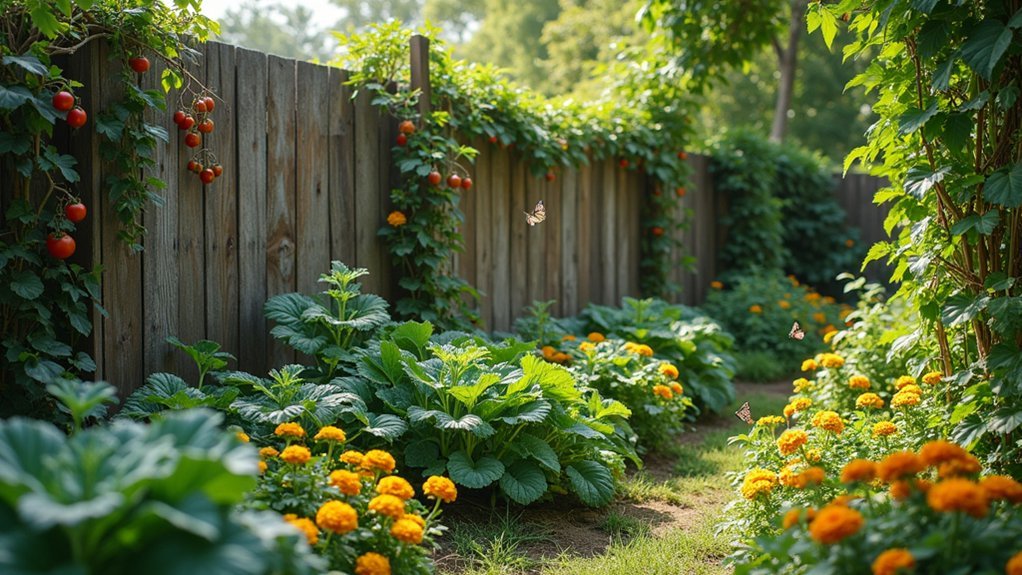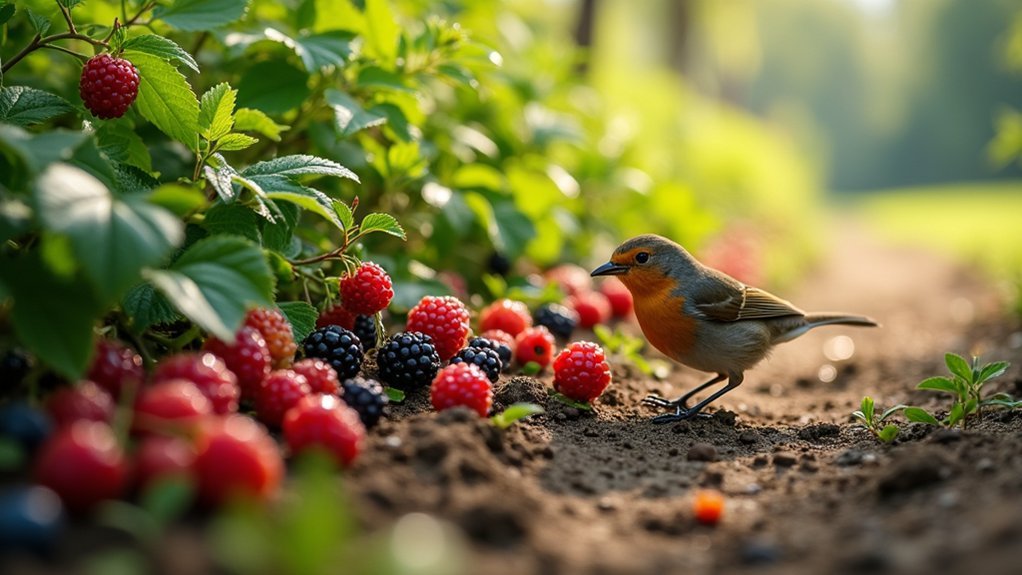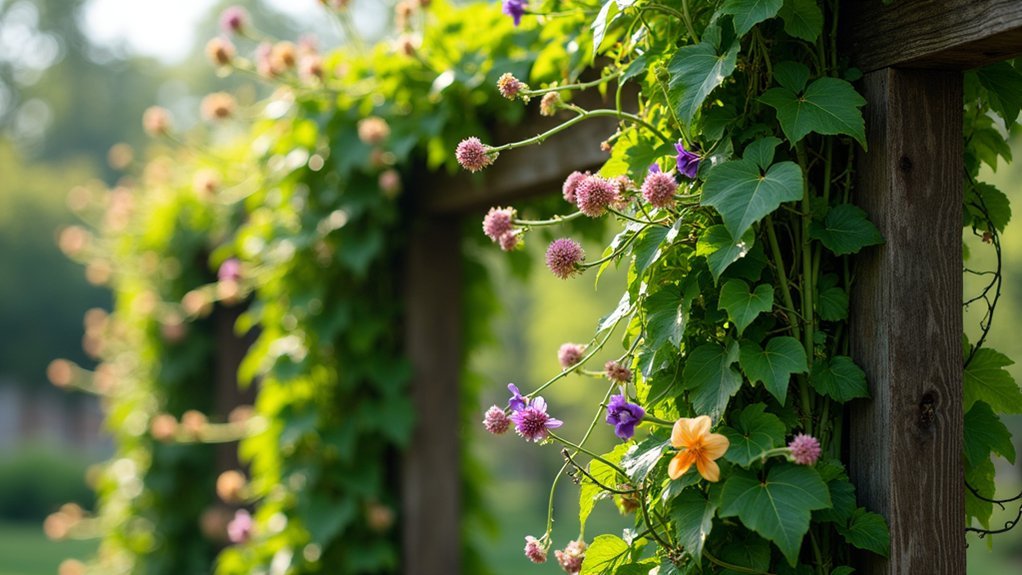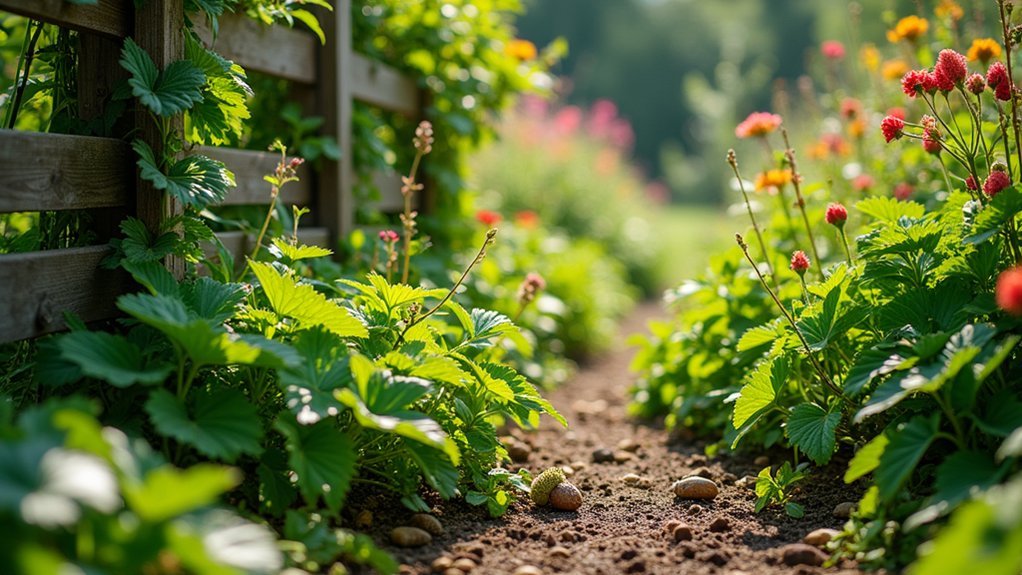Create wildlife-welcoming edible boundaries by planting native berries in clusters, incorporating multi-layered plantings from ground covers to tall trees, and selecting cross-pollinating fruit varieties. Add nut trees as living fence posts, integrate climbing vines for vertical habitat, and design corridors at least 6 feet wide with year-round food sources. Don’t over-prune—share your harvest with birds and beneficial insects who’ll reward your garden with natural pest control and increased biodiversity.
7 Wildlife-Welcoming Edible Boundary Tips

Three key approaches can transform your property edges into thriving ecosystems that benefit both you and local wildlife.
First, integrate multiple plant types without clear delineations—mixing fruits, nuts, flowers, and herbs creates natural ecological interactions that support diverse species.
Second, prioritize native edible plants like Black Walnut, Hawthorn, and Blackthorn. These provide better habitat than ornamentals while offering food for both you and wildlife throughout different seasons. Serviceberry trees with their edible berries attract various birds and pollinators while providing delicious fruits for jams and jellies.
Hazel and blackberry offer excellent complementary benefits.
Finally, adjust your maintenance expectations. You’ll need to share harvests with birds and mammals, especially during scarce periods, and repair gaps after plant removal.
Remember that these boundaries function as movement corridors for wildlife in fragmented landscapes, connecting otherwise isolated habitats.
Native Edibles That Attract Local Wildlife
Native edibles form the backbone of any wildlife-welcoming boundary, offering both sustenance for you and habitat for local fauna.
You’ll find that berry-producing shrubs attract beneficial birds that control garden pests, while pollinator-friendly fruit trees create a continuous nectar buffet throughout growing seasons. Consider planting persimmons which are rich in vitamins and attract wild and domesticated bees that aid in fruit formation.
Berries For Beneficial Birds
While creating edible boundaries for your property, incorporating native berry plants offers a powerful way to support local bird populations throughout the year. Birds strongly prefer native berries over introduced varieties, finding them more nutritious and aligned with their dietary needs. Research by Douglas Tallamy confirms that native berries provide higher fat content than nonnative alternatives.
Consider serviceberry for early-summer nutrition during the critical breeding season, or winterberry to provide bright red fruits that persist through snow. Elderberry’s high-fat content fuels migratory birds, while blueberry plants support hundreds of beneficial insect species.
For maximum impact, plant in clusters of 3-5 shrubs, creating protective density that birds prefer. Avoid deadheading spent flowers, and remember that unmodified native species offer superior nutrition compared to cultivated varieties.
Pairing your berry plantings with nearby water sources completes an ideal habitat that benefits both birds and your landscape.
Pollinator-Friendly Fruit Trees
Creating a boundary that serves both humans and wildlife requires thoughtful selection of pollinator-friendly fruit trees that provide food for your family while supporting local ecosystems.
Consider planting self-pollinating varieties like apricots, peaches, and sour cherries if you’re working with limited space.
For larger areas, cross-pollinating trees such as apples, pears, and sweet cherries create a more robust habitat. You’ll need multiple compatible varieties for successful fruiting, but the ecological benefits are substantial.
Native fruit tree species are particularly valuable additions, as they’re already adapted to your local climate and readily recognized by indigenous pollinators. Serviceberry trees provide edible fruit that can be used to make delicious jams while attracting birds to your garden.
Enhance your fruit tree boundary by incorporating flowering plants nearby to attract diverse beneficial insects. This integrated approach creates an edible ecosystem where you’ll enjoy harvests while providing essential resources for bees, butterflies, and birds.
Edible Hedge Ecosystems
Transforming your garden boundaries into edible hedge ecosystems offers a sustainable approach that benefits both your table and local wildlife. Native species like Hazelnut and Wild Raisin provide food while supporting biodiversity.
These living borders require less maintenance than traditional hedges while delivering fruits, nuts, and edible leaves throughout the seasons. A recommended minimum width of 6 feet ensures proper development of your edible hedge ecosystem.
When selecting plants for your edible hedge, consider:
- Climate tolerance and native origin to guarantee plants thrive without excessive intervention
- Wildlife attraction potential, choosing varieties like Golden Currant that provide nectar for pollinators
- Maintenance requirements, focusing on low-input options like Arrowwood or Big Saltbush
You’ll create a resilient boundary that produces food, enhances local ecology, and adds beauty to your landscape—all while using fewer resources than conventional gardens.
Creating Multi-Layered Boundary Plantings
To establish a truly effective wildlife haven, multi-layered boundary plantings require thoughtful vertical organization from ground level to canopy. Start by planting tall trees like oaks as your canopy layer, followed by fruiting shrubs that offer food and nesting sites. Add perennial herbs and flowers to attract pollinators, and finish with groundcovers to complete the habitat spectrum. Periodic root pruning near cropland will minimize competition for nutrients and water between your boundary plantings and agricultural areas.
| Layer | Plant Types | Wildlife Benefits | Seasonal Interest |
|---|---|---|---|
| Canopy | Oak, pine, fruit trees | Winter food, nesting | Spring flowering, fall color |
| Shrub | Elderberry, hazelnut, currants | Berries, shelter | Summer fruits, varied bloom times |
| Herb | Wildflowers, lavender, thyme | Nectar, seeds | Continuous flowering cycles |
| Ground | Native grasses, strawberry | Insect habitat, cover | Year-round structure, spring fruits |
Remember to include both deciduous and evergreen species for year-round structure while allowing leaf litter to remain as habitat for beneficial insects.
Seasonal Berries for Year-Round Wildlife Support

While many gardeners focus primarily on summer harvests, strategic selection of berry-producing plants can sustain wildlife throughout all seasons. By incorporating native varieties like winterberry, dogwood, and viburnum, you’ll create a reliable food source that local birds prefer over non-native options.
These plants not only provide essential nutrition during critical migration and nesting periods but also enhance your landscape’s beauty. Northern bayberry produces waxy gray berries with exceptionally high fat content that provides crucial energy for winter birds.
- Pair early-fruiting serviceberries with late-season winterberries to maintain continuous food availability from summer through winter
- Include male and female winterberry plants to guarantee those brilliant red berries that persist through the harshest months
- Mix shrubs of varying heights to optimize space while creating multiple feeding zones for different bird species
Nut Trees and Shrubs as Living Fence Posts
Beyond berries, your edible boundary can feature nut trees and shrubs that serve dual purposes as both living fence posts and wildlife pantries. These nutrient-rich additions create structural integrity while offering protein-packed treats for both you and local fauna. Consider incorporating a mix of over-story trees for height variation and visual interest in your living fence.
| Tree Type | Wildlife Benefits | Spacing Needs |
|---|---|---|
| Almonds | Attracts birds | 15-20 feet |
| Walnuts | Squirrel habitat | 30-40 feet |
| Pecans | Winter food | 40-60 feet |
| Hazelnuts | Small mammal haven | 10-15 feet |
Combine your nut trees with complementary plants for a multifaceted boundary. You’ll enjoy seasonal interest from spring blooms to autumn colors, while providing essential wildlife nourishment. Remember to maintain proper pruning and soil care—your living fence will reward you with decades of beauty, privacy, and biodiversity support.
Climbing Vines for Vertical Habitat Enhancement

Vertical habitat space, often overlooked in boundary plantings, becomes an ecological goldmine when you incorporate climbing vines.
These natural climbers transform fences, trellises, and arbors into thriving wildlife corridors that connect fragmented habitats while providing food, shelter, and nesting sites.
Choose native varieties like Virginia creeper, trumpet vine, or American wisteria for best results. They’re adapted to local conditions and support local wildlife more effectively than non-natives. Crossvine with its clusters of vibrant orange-red blooms serves as an early nectar source for hummingbirds and other pollinators when many other plants aren’t yet flowering.
Train your vines on sturdy structures that can accommodate their growth and provide safe access for birds and pollinators.
- Combine flowering and fruiting species for year-round wildlife support
- Create microhabitats by layering vines with different growth habits
- Maintain regular pruning to prevent overgrowth while preserving wildlife value
Designing Wildlife Corridors Within Boundary Systems
You can enhance your property’s ecological value by creating strategic wildlife corridors through your boundary plantings that connect fragmented habitats on either side.
Design these passageways with year-round functionality by incorporating evergreens for winter shelter, summer fruiting plants, and fall seed producers that support wildlife movement across seasons.
When planning these corridors, vary the height and density of plantings to accommodate different species’ needs, ensuring even small properties can serve as essential links in the larger habitat network. Aim for a corridor width of at least 300 meters where possible to provide necessary adequate width for wildlife to access food and refuge during their journey.
Connecting Fragmented Habitats
When designing edible boundaries, creating wildlife corridors becomes essential for maintaining biodiversity in your landscape.
You’re not just growing food—you’re building bridges between fragmented habitats that allow species to migrate, find mates, and adapt to changing conditions.
Consider how your property fits into the larger ecological context. Even small corridors can greatly impact local wildlife by providing safe passage through otherwise inhospitable terrain.
By connecting isolated habitat patches, you’ll help maintain genetic diversity among wildlife populations. These connections are crucial for ecosystem health and sustaining biodiversity similar to larger conservation efforts.
- Plant native berry bushes in clusters that extend toward nearby natural areas
- Create “stepping stone” habitats with water features and shelter spaces
- Vary vegetation height and density to accommodate different species’ movement needs
Remember that well-designed corridors need minimal human disturbance and sufficient width to function effectively.
Multi-season Wildlife Passages
Designing wildlife passages that function throughout all seasons represents the next evolution in boundary planning.
You’ll need to incorporate diverse microhabitats to accommodate varying species’ needs during seasonal migrations. Consider how your passage will perform under different weather conditions—snow cover, heavy rains, or drought.
Include a mix of native vegetation that provides year-round shelter and food sources. Following the example of the hypar-nature design, integrate protective cover like scree fields and forests to create animal-friendly habitat zones. Structural integrity is essential, as your passage must support heavier loads than conventional structures while maintaining a 70-80 year lifespan.
Utilize modular designs like hypar vaults that can be adapted to your specific landscape requirements.
Remember that effective passages don’t follow a standard distance formula—they’re tailored to local wildlife patterns. Support your design with research-driven monitoring to guarantee long-term effectiveness and adapt as environmental conditions change over decades.
Frequently Asked Questions
How Do I Deter Unwanted Wildlife Like Deer From Edible Boundaries?
You’ll need tall fencing, deer-resistant plants like rosemary and thyme, organic repellent sprays, or motion-activated deterrents. Try combining physical barriers with strong-smelling herbs that deer avoid.
Can Edible Boundaries Work in Small Urban Gardens?
You’ll maximize small urban spaces with multi-tiered planting, dwarf varieties, and vertical crops. Use walls for passion fruit, create modular containers for herbs, and incorporate edible ground covers to suppress weeds and utilize every inch.
What Maintenance Is Required for Wildlife-Friendly Edible Fences?
You’ll need to prune regularly, monitor plant health, replace damaged sections promptly, control invasive growth, maintain proper wire tension, and clear debris from crossing points to keep your wildlife-friendly edible fence effective.
How Long Until Edible Boundaries Provide Substantial Wildlife Habitat?
You’ll see early benefits within 1-3 years as shrubs establish. Substantial habitat develops in 5-7 years, with full maturation taking 10-20 years depending on your plant selection and local growing conditions.
Are There Toxic Edible Plants to Avoid When Children Frequent the Garden?
You should avoid toxic plants like rhubarb leaves, unripe tomatoes, elderberry bushes, and potato foliage when children are in your garden. Always research plants thoroughly and teach kids which parts aren’t edible.
In Summary
Your edible boundary doesn’t just define your property—it creates a thriving ecosystem. By incorporating these seven strategies, you’ll enjoy fresh harvests while providing essential habitat for local wildlife. Remember, you’re not just growing food; you’re building biodiversity right in your backyard. Start with one section this season, and you’ll soon witness the beautiful balance between productive gardening and wildlife conservation unfolding before your eyes.





Leave a Reply